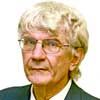Professor Dermot Keogh has various academic titles to his name but University College Cork, of which he is a veteran member, may be considered his true cradle and constant touchstone.
Even if a huge percentage of Irish-Argentines notoriously originate from the Midland counties of Westmeath and Longford, Cork has produced perhaps more than its fair share of outstanding names making their mark in Argentina – ranging from the late ex-priest Patrick Rice (the main subject of one of the seven chapters of this book and in some ways its inspiration) in the higher sphere of human rights idealism to the entrepreneurial Jack Murphy at an earthlier level.
On the back cover of this book, former Buenos Aires Herald editor Robert Cox pays tribute to the “meticulous erudition” of Keogh’s research and this description is fully borne out by the lavish use of the somewhat outdated academic norm of footnotes – the total of 764 pages (which some would-be readers might find intimidating) would be at least halved without them. Over the top in some eyes but necessary to make manifest the exhaustive wealth of sources underpinning this chronicle.
Keogh’s stage is vast but his cast is relatively limited – as many as a million Argentines might have Irish blood but this book does not so much focus on the community (more socially diffuse than usually imagined) as an undermanned embassy from Matthew Murphy in 1947 (or even back to 1919 with Eamonn Bulfin – the 1916 Easter Rising rebel only saved from execution by his Argentine citizenship along similar lines to his New York-born namesake Eamon de Valera – according to some criteria) and the “soft power” of Irish Catholic clergy. Although “undermanned” might not be quite the right word when looking at the contributions of such ambassadors as Paula Slattery (2000-2004), Philomena Murnaghan (2006-2010) and Jacqueline O’Halloran, heading the mission since 2018 and leaving in a few months, alas. Curiously enough there is minimal overlap between Irish immigration and a diplomatic presence here with up to 50,000 arriving since 1830 but less than 2,000 since 1925.
While the first half of the last century up to 1955 is covered by the opening two chapters, fully three of the seven chapters are devoted to Argentina’s darkest decade up to 1983 with the youthful diplomat Justin Harman (later to be the 2014-2017 ambassador) and the late Monsignor Kevin Mullen heading the supporting cast to Patrick Rice. But the last of the seven chapters may well be the most topical with the 40th anniversary of the South Atlantic War now only three weeks away – Ireland’s idiosyncratic take on that conflict and sanctions under the colourful leadership of Charles “The Boss” Haughey, to which Keogh gives a full and scholarly context. One good reason to lay hands on this book in the near future.
The space remaining allows for little more than a mention of the visible hand of the translator Jorge Rafael Abuchedid and the more invisible sponsorship of Justin Harman and Paula Ortiz of the Asociación de Estudios Irlandeses del Sur (AEIS) with Irish President Michael D. Higgins no less writing the prologue.
Saint Patrick’s Day Celebrations
This year’s celebrations of Saint Patrick’s Day will centre on the first ministerial visit in this decade – Catherine Martin, the Minister for Tourism, Culture, Arts, the Gaelic language (Gaeltacht), Sports and Media, an up-and-coming Green Party politician who sits for Dublin Rathdown. She will be greeted with an official diplomatic reception at the Irish Embassy residence in Olivos on Tuesday evening and a community reception the next day at the same venue.
Dermot Keogh’s book, reviewed here, will take pride of place on Saint Patrick’s Day itself (Thursday, March 17), being launched by Martin at an event in the National Library at noon. The next day the minister will open an exhibition on Irish-Argentina bilateral relations at the Foreign Ministry with Foreign Minister Santiago Cafiero.
Aside from this official programme, the Irish community will also be playing its part with events such as the festival at Saint Bridget’s and a parade next Saturday with some activities the same day in the Hurling Club.






















Comments